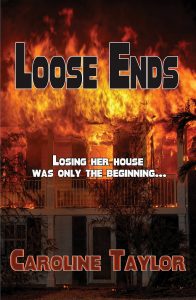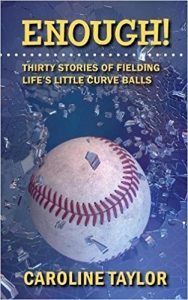FREE FALLING INTO THE UNPLOTTED NOVEL
 It was a dark and stormy night, which was not getting me off to a good start. But at least there were words on the page. I had a great idea, I knew where I wanted it to go, sort of. All I had to do was inject a good dose of drama and some fascinating characters to help me connect the dots. And then, of course, rewrite the first line.
It was a dark and stormy night, which was not getting me off to a good start. But at least there were words on the page. I had a great idea, I knew where I wanted it to go, sort of. All I had to do was inject a good dose of drama and some fascinating characters to help me connect the dots. And then, of course, rewrite the first line.
Does this sound familiar? That’s what it’s like to write a novel without a plot. I should know with three published novels under my belt. Don’t get me wrong. I’m a big fan of outlines. I couldn’t have written my nonfiction book without one. The virtue of outlines—or plotting in fiction—is that they keep you on track.
The drawback, at least to my way of thinking and only when writing fiction, is that plotting can put you in a box. There’s a whole world of what if’s out there that you might not even perceive while you’re trying to stick to the story you first plotted. After all, you’ve devoted a great deal of time and thought to deciding that the characters will face a certain dilemma. Given the traits that you’ve created for them, they will take certain steps to resolve that dilemma. And, at least when it comes to thrillers, you’ve included all sorts of obstacles thrown in their way. If that’s not enough, you’ve got to sneak the back story into things in a way that won’t have readers yawning. Plotting might make this task manageable, but it can also close off some options.
Here’s an overly simplified example of the plotting straitjacket I’m talking about: Suppose your plot involves two people discovering that a prominent legislator committed murder when he was a young man. They can’t go to the local police because the cops are in the legislator’s pocket; otherwise, there would be no story. A subplot involves the man’s infidelity and a heretofore obedient, loyal wife who leaves him, midway through the story. According to the plot, the two lead characters will confront the man with his dirty deed at the novel’s climactic moment. He is too powerful and too protected for the confrontation to occur at the state house where there are likely to be plenty of witnesses. So it will occur at his home. Only, with the wife gone, the confrontation becomes a “he said, they said” moment that turns your thriller into a tepid legal tome. You can go back and rework the plot, or you can free fall into the story and let it carry you on an unexpected journey to an exciting end.
The great thing about writing fiction is the opportunity to create people from whole cloth—or at least loosely based on people you know or that you’ve observed. What I discovered when I tried to stick to the characters I had devised for one of my novels was that fictional characters have minds of their own. They might decide they are tall, not short; they prefer wine, not whisky; they drive recklessly; they smoke; they can dance up a storm even though they’re in their sixties. If you let them have their way all the time, however, the story might veer off in an unintended direction. Many writers can force their characters to follow the destiny laid out for them in the plot, but who wants grumpy characters?
Suppose you have a character who starts out being an all-American good guy when the plot calls for him to turn out to be the villain. You’ve made him a good guy to put readers off the scent, although you’ve also carefully salted the story with subtle hints about his true nature. He’s neat and clean and quiet. He clearly adores the female protagonist. He keeps asking her out on dates. But he’s not getting anywhere with being Mr. Nice Guy, so he goes over to the dark side. What if he makes it abundantly clear that he does not want to go there? In a plotted story, you can try forcing him into that role, even though I suspect he’ll fight you every step of the way. In my kind of controlled chaos, you could create a new villain, imagining someone else in that role. You could make Mr. Nice Guy the red herring. You could have him emerge as the real hero at the end. Or you could kill him off at a tender moment when the woman realizes what a fool she’s been to have rejected him. You can even make the villain another woman. Or a relative of Mr. Nice Guy. You can play God.
There’s a name for writers like me—a name I only recently heard about in a radio interview. Apparently, in the writing world, you are either a plotter or a pantser (as in, seat-of-the). I fall into the latter category. Luckily, I am not alone. Ann Tyler has said that she does not plot out her novels and that she often lets the characters take her where they want to go. I started my first novel with a vague idea that it would be fun to spoof the hard-boiled private eye genre with a twenty-something investigator who admires Philip Marlowe and the Continental Op. Right off the bat, I ran into trouble. The novel was based in Annapolis, and the Maryland law that licenses private investigators calls for at least ten years of law enforcement experience. So scratch that. It was the character herself who let the thought slip into my dreams one night: Why not just pretend to be a private eye?
 Free falling through a story without a plot also has its challenges. My current novel started out, as intended, with a home invasion, followed by an explosion that destroys the lead character’s house, car, and business. I meant for the story to involve her having to flee the city and change her identity, and I went quite far in that direction, including having her decide where she would go and arrange to obtain a driver’s license in a phony name. But the protagonist made me realize something I would have known had I devised a plot for the book: If she did actually disappear, she would never find out who was out to get her, let alone why. In other words, that would be the end of my story.
Free falling through a story without a plot also has its challenges. My current novel started out, as intended, with a home invasion, followed by an explosion that destroys the lead character’s house, car, and business. I meant for the story to involve her having to flee the city and change her identity, and I went quite far in that direction, including having her decide where she would go and arrange to obtain a driver’s license in a phony name. But the protagonist made me realize something I would have known had I devised a plot for the book: If she did actually disappear, she would never find out who was out to get her, let alone why. In other words, that would be the end of my story.
I had fully intended for the two main characters to reach that happy ending we all want from escapist fiction. But, again, one of them pointed out that it would strain credulity to have both of them come out unscathed. I had also meant for the friendship between the lead character and the friend who gives her shelter to survive all the trauma and risk associated with this act of kindness. Really? Would that be the likely outcome if you were that friend?
Walking the tightrope between maintaining the suspension of disbelief and engendering full-on skepticism in the reader remains a challenge, without a plot or with one. I just happen to think that not having a plot makes it possible to change things that need to be changed without unraveling the carefully woven thread that is created through plotting.
All of these factors have made the writing journey an exciting one for me. Most of the time, I really do feel like I am free falling through the experiences I’ve envisioned and the ones my characters thrust into my path. It can be a confusing, scary trip, but it also takes me to places I never thought I’d go.
—
Caroline Taylor is the author of three mystery novels—“What Are Friends For?” “Jewelry from a Grave,” and “Loose Ends”—one nonfiction book, “Publishing the Nonprofit Annual Report: Tips, Traps, and Tricks of the Trade,” and numerous short stories and essays, which are featured on her website at www.carolinestories.com. A collection of short stories, “Enough: Thirty Stories of Fielding Live’s Little Curve Balls,” is forthcoming from Literary Wanderlust in April 2018. A suspense novel, “The Typist” is forthcoming from Black Rose Writing in April 2018. A longtime resident of Washington, DC, she now lives in North Carolina.
# # #
About Loose Ends
LOSING HER HOUSE WAS ONLY THE BEGINNING …
When Carson Abbott Mahoney’s house is blown up, she decides it’s time to disappear. She can’t go to the police because she is the primary suspect in the murder of her former husband. Meanwhile, Carson’s sister Cam is on the run from the West Virginia commune where she sought refuge as “Sister Leah,” but instead found horrors causing her to kill the leader.
Like her sister, she is also paranoid about jail, a fear stretching back to when they were imprisoned as teens for their parents’ debts in a foreign country where raping female captives was considered a job perk. Cam chooses a desperate act that lands her at death’s door, while Carson discovers she is one of many LOOSE ENDS to be dealt with because of her former husband’s small, but significant, role in an assassination.
Enough: Thirty Stories of Fielding Live’s Little Curve Balls
 Curve balls have many forms, and so do the ways we handle the ones that life pitches at us.
Curve balls have many forms, and so do the ways we handle the ones that life pitches at us.
Praise for Enough!
“Caroline Taylor’s stories are taut, pointed, and consistently intriguing–not to mention potent reminders of the dramatic arcs that shape even the most ordinary lives.”–Louis Bayard, author of Lucky Strike.
“Attention is the rare and pure form of generosity. In ENOUGH!, Caroline Taylor pays attention to the small heroes of our everyday lives: those important cogs that surround us. She presents them with both wit and grace.”–Ruth Moose, professor emeritus of creative writing at the University of Carolina, and author of Neighbors and Other Strangers as well as two other short story collections and two mystery novels
In Enough! Thirty Stories of Fielding Life’s Little Curve Balls, Caroline Taylor has compiled some of the best of her short stories into one captivating, memorable volume.–Colorado Book Review
Category: Contemporary Women Writers, How To and Tips

























